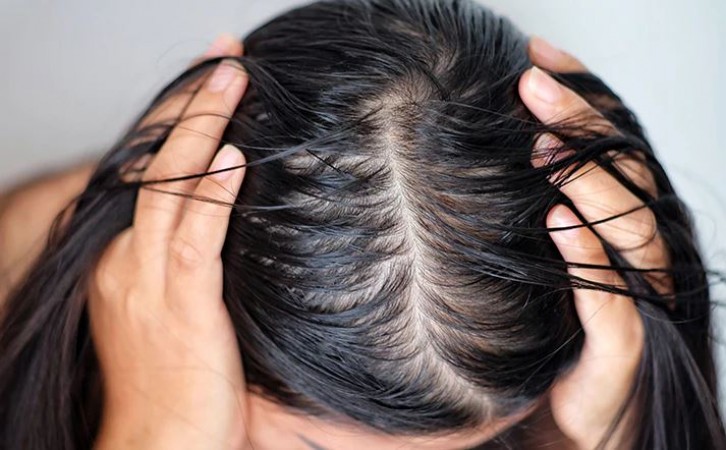
Maintaining shiny hair can be a challenge, especially when hair products leave a sticky residue, leading to itchiness and discomfort on the scalp. This not only affects your mood but also your overall appearance, undermining your confidence. However, there are natural remedies that can alleviate these concerns and help restore the luster to your hair.
Reetha (Soapnut)
Reetha, also known as soapnut, is a natural cleanser that has been used for centuries in traditional hair care practices. Its saponin content makes it an effective alternative to chemical-laden shampoos, especially for individuals with oily hair.
To prepare a reetha hair rinse, start by soaking a handful of reetha in a cup of warm water for at least an hour. This soaking process helps release the beneficial compounds present in the soapnut. After soaking, boil the mixture until the water reduces by half and attains a soapy consistency.
Once the reetha solution is ready, strain out the liquid to remove any solid particles. It's essential to strain the solution thoroughly to ensure a smooth application and easy rinsing. The resulting liquid can be used as a natural shampoo to cleanse the scalp and hair.
When applying the reetha rinse, ensure that your hair is thoroughly wet. Massage the solution gently into your scalp, working it through the lengths of your hair. Focus on areas prone to oiliness, such as the roots and crown. Allow the reetha solution to sit on your hair for about 15 minutes to allow its cleansing properties to take effect.
After the designated time, rinse your hair thoroughly with lukewarm water. It's crucial to rinse your hair well to remove any residue and prevent buildup. With regular use, reetha can help control excess oil production, leaving your hair feeling clean, refreshed, and free from greasiness.
Shikakai and Amla (Indian Gooseberry)
Shikakai and amla are two powerhouse ingredients commonly used in Ayurvedic hair care. Shikakai is known for its gentle cleansing properties, while amla is revered for its nourishing and conditioning benefits. Together, they form a potent combination for maintaining healthy, lustrous hair.
To create a shikakai and amla shampoo, start by boiling two cups of water in a saucepan. Once the water reaches a rolling boil, add a tablespoon each of shikakai and amla powder to the pot. Reduce the heat and allow the mixture to simmer until the water reduces by half.
After simmering, strain the liquid to remove any residue and solid particles. The resulting solution should have a smooth consistency, ideal for application to the hair and scalp. Allow the solution to cool slightly before use to avoid scalding the scalp.
When applying the shikakai and amla shampoo, wet your hair thoroughly to ensure even distribution. Pour the solution over your scalp and hair, massaging gently to work up a lather. Focus on massaging the scalp to stimulate circulation and promote hair growth.
After massaging the shampoo into your hair, rinse thoroughly with lukewarm water. It's essential to rinse your hair well to remove any traces of shampoo and prevent buildup. With regular use, shikakai and amla shampoo can help maintain scalp health, control oiliness, and promote shiny, manageable hair.
Henna Hair Pack
Henna, derived from the leaves of the Lawsonia inermis plant, has been used for centuries as a natural hair dye and conditioning treatment. Its natural properties not only impart a reddish hue to the hair but also help strengthen and nourish the strands from root to tip.
To create a henna hair pack, start by obtaining high-quality henna powder from a reputable source. In a bowl, combine five tablespoons of henna powder with two tablespoons each of coconut oil and aloe vera gel. The addition of coconut oil helps moisturize the hair, while aloe vera gel soothes the scalp and promotes hair health.
Mix the ingredients thoroughly until you achieve a smooth, uniform paste. The consistency should be thick enough to adhere to the hair without dripping excessively. If the mixture is too thick, you can add a small amount of water to achieve the desired texture.
Before applying the henna hair pack, ensure that your hair is clean and free from any styling products or residue. Section your hair into manageable sections to facilitate even application. Using a hair dye brush or gloved hands, apply the henna paste to your hair, starting from the roots and working your way down to the ends.
Once your hair is fully coated with the henna mixture, cover it with a shower cap or plastic wrap to prevent the dye from drying out. Allow the henna to sit on your hair for at least one hour to allow the dye to develop and penetrate the hair shaft.
After the designated time has elapsed, rinse your hair thoroughly with lukewarm water until the water runs clear. Avoid using shampoo immediately after rinsing, as this can strip away the natural oils and interfere with the henna's conditioning properties. Allow your hair to air dry or style as desired, reveling in its newfound shine and vitality.
In conclusion, incorporating natural remedies such as reetha, shikakai, amla, and henna into your hair care routine can help combat oily hair and promote overall scalp health. By harnessing the power of these time-tested ingredients, you can achieve hair that is clean, vibrant, and full of life, without resorting to harsh chemicals or treatments.
Never Take These Foods on an Empty Stomach for Better Health
Top 10 Wholesale Business Ideas
Samsung Set to Launch Galaxy Ring Alongside Z Fold 6 and Z Flip 6: What to Expect"